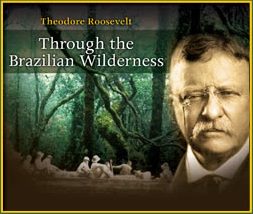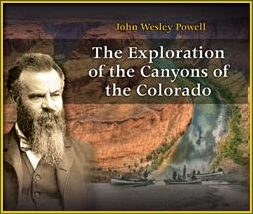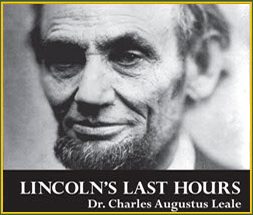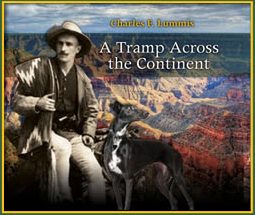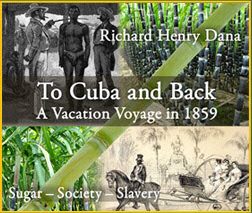Subscribe now to automatically receive our Listen2Read blog:
Listen to Samples From the Audiobooks:
Recent Posts
HOW TITUSVILLE PENNSYLVANIA SAVED THE WHALES
CHRISTMAS ON STORMY SOUTH AFRICAN SEAS WHERE THE WORLD IS STILL FLAT
THE DOOMED MEN OF THE COLORADO RIVER
THE MORNING WHEN PRESIDENT LINCOLN DIED
WHAT HAPPENED TO AMELIA EARHART’S AIRPLANE ‘THE FRIENDSHIP”?
Additional Listen2Read Titles
-
Unabridged
Narrative of the Most Extraordinary and Distressing Shipwreck of the Whale Ship Essex
$14.95 – $29.95 Preview
CHARLES FLETCHER LUMMIS AND THE FESTIVAL OF THE DEAD

About this time of the year in 1884, Charles Fletcher Lummis walked with his dog into the New Mexican Indian Pueblo of Isleta, a short distance from Albuquerque, but a world apart.
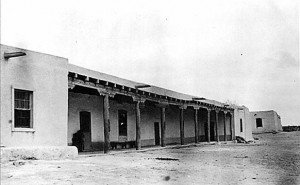
In Spanish, Isleta means “little island” and the Native American life style was an island of culture, different from American city life. Lummis described Isleta as “one of the prettiest places in New Mexico.”
Isleta’s roots reach back to the 14th century, a fact that Lummis witnessed for himself and described in his book, “A Tramp Across the Continent,” which I have recorded as a Listen2Read audiobook.
Lummis wrote:
“To-day, the aboriginals who sleep nine feet deep in the bosom of the bare gravel graveyard in front of the quaint church of the pueblo of Isleta have the first square meal they have enjoyed in a 12 month.”

Lummis was describing the Fiesta De Los Muertos, The Festival of the Dead. The Fiesta was being celebrated in Isleta when Lummis visited, as it had been celebrated for hundreds of years, before Mexico was Mexico, before Columbus was supposed to have discovered America and before the introduction of Christianity.
It was explained to me that the tradition began in the time of the Aztecs with the Goddess Mictecacihuati. In Aztec mythology, she was the queen of Mictian, the underworld, where the souls of the departed go. That square meal that Lummis was referring to was the practice of leaving food for the visiting spirits.

I was told that the belief behind the Fiesta De Los Muertos was that at midnight, on October 31, the gates of the underworld are opened and the spirits of the deceased children are allowed to reunite with their families for 24 hours.
On November 2, the spirits of the adults are released. In the afternoon, the festivities are taken to the graveyard, where tombs are cleaned and there is a happy atmosphere with costumes, skeletons and maybe a little Mescal. The idea is to remember the dead and not to mourn to them.

The Mission Padres tried to convert people and move them away from their pagan tradition. However, the Padres couldn’t fight the concept of the Festival and so, since the festival coincides with All Saints Day (November 1) and All Souls day (November 2), the Padres wrapped everything together. The vigil for these days is October 31, Halloween eve. It is the melding of European and Aztec cultures.

Lummis wrote:
“Marching through the opening in the high adobe wall which surrounds the graveyard, each woman went to the spot whose gravel covered beloved bones, set her basket down there, planted a lot of candles around it, lighted them, and remained kneeling patiently behind her offering. It was a quaint and impressive sight there under the bright New Mexico sun…the hundred kneeling women, weeping quietly under their shawls while the dead ate to their heart’s content, according to the belief of these simple folk.”
The baskets were then taken into the church and deposited in the priest’s quarters to provide the padre with a more earthly nourishment.

The Acheson, Topeka and Santa Fe railroad had reached a point 4 miles from Isleta in 1879, providing a touching point with the future. For Lummis to be there in that pueblo, graveyard and church, with those people at that moment in time, was to be almost transported into history in a touching point with the past. He was literally between two worlds.
Several years after he became the City Editor for the Los Angeles Times, Lummis had a stroke and couldn’t use his left arm. Unable to continue in his profession, Lummis, having fond memories of his time in Isleta, returned to the pueblo to heal. This began a lifelong appreciation for Native American life and the American Southwest. Lummis gained strength in Isleta and began writing the magazine articles and stories about the Southwest that made him famous.
Those of you who have visited a pueblo community, as I have, know that the pueblo world is an incredibly different world from ours with an atmosphere and spirit that is difficult to describe and can only be experienced.

On his thirty five hundred mile walk from Ohio to California, Lummis wrote stories of his adventures for the Los Angeles Times, sending them from railroad terminals, when he found them. Eventually, he edited many of these stories into a collection, published under the title “A Tramp Across the Continent” (Preview: https://listen2read.com/a-tramp-across-the-continent/). In this book, he describes the advent of the modern age, relentlessly destroying the Old West – but not at the Pueblos, which were and are remarkably timeless. Well, not totally timeless – there is now a gambling resort and Casino in Isleta.
Andre Stojka
Publisher
Listen To Read
Audiobooks
©Listen2Read
Additional Listen2Read Titles
-
Unabridged
Narrative of the Most Extraordinary and Distressing Shipwreck of the Whale Ship Essex
$14.95 – $29.95 Preview



